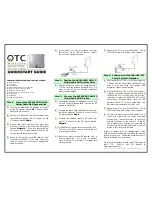
Single Point Setup
Single Point Setup Overview
Cisco Small Business WAP371 Wireless Access Point Administration Guide
143
10
Single Point Setup allows the management of more than one cluster in the same subnet or
network; however, they are managed as single independent entities. The table below shows
Single Point Setup wireless service limits.
A cluster can propagate configuration information, such as VAP settings, QoS queue
parameters, and radio parameters. When you configure Single Point Setup on a device,
settings from that device (whether they are manually set or set by default) are propagated to
other devices as they join the cluster. To form a cluster, make sure the following prerequisites
or conditions are met:
STEP 1
Plan your Single Point Setup cluster. Be sure the two or more WAP devices you want to cluster
are compatible with each other. For example, Cisco WAP371 devices can only cluster with
other Cisco WAP371 devices.
NOTE
It is strongly recommended to run the latest firmware version on all clustered
WAP devices. Firmware upgrades are not propagated to all WAP devices in a cluster;
you must upgrade each device independently.
STEP 2
Set up the WAP devices that will be clustered on the same IP subnet and verify that they are
interconnected and accessible across the switched LAN network.
STEP 3
Enable Single Point Setup on all WAP devices. See
Access Points
.
STEP 4
Verify that the WAP devices all reference the same Single Point Setup name. See
Access
Points
.
Single Point Setup Negotiation
When a AP is enabled and configured for Single Point Setup, it begins sending periodic
advertisements every 10 seconds to announce its presence. If there are other WAP devices that
match the criteria for the cluster, arbitration begins to determine which WAP device will
distribute the master configuration to the rest of the members of the cluster.
The following rules apply to Single Point Setup cluster formation and arbitration:
•
For existing Single Point Setup clusters, whenever the administrator updates the
configuration of any member of the cluster, the configuration change is propagated to
Group/Cluster Type
WAP Devices per
Single Point Setup
Number of Active
Clients per Single
Point Setup
Maximum Number
of Clients (Active
and Idle)
WAP371
16
960 for the WAP371
with a dual radio
2048 for the
WAP371 with a dual
radio















































